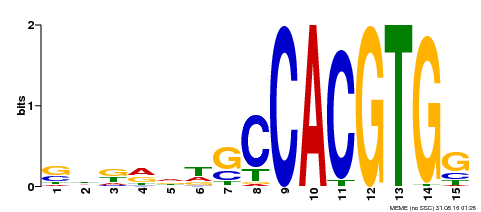- Riechmann JL, et al.
Arabidopsis transcription factors: genome-wide comparative analysis among eukaryotes.
Science, 2000. 290(5499): p. 2105-10
[PMID:11118137] - Heim MA, et al.
The basic helix-loop-helix transcription factor family in plants: a genome-wide study of protein structure and functional diversity.
Mol. Biol. Evol., 2003. 20(5): p. 735-47
[PMID:12679534] - Toledo-Ortiz G,Huq E,Quail PH
The Arabidopsis basic/helix-loop-helix transcription factor family.
Plant Cell, 2003. 15(8): p. 1749-70
[PMID:12897250] - Bailey PC, et al.
Update on the basic helix-loop-helix transcription factor gene family in Arabidopsis thaliana.
Plant Cell, 2003. 15(11): p. 2497-502
[PMID:14600211] - Castelli V, et al.
Whole genome sequence comparisons and "full-length" cDNA sequences: a combined approach to evaluate and improve Arabidopsis genome annotation.
Genome Res., 2004. 14(3): p. 406-13
[PMID:14993207] - Gong W, et al.
Genome-wide ORFeome cloning and analysis of Arabidopsis transcription factor genes.
Plant Physiol., 2004. 135(2): p. 773-82
[PMID:15208423] - Khanna R, et al.
A novel molecular recognition motif necessary for targeting photoactivated phytochrome signaling to specific basic helix-loop-helix transcription factors.
Plant Cell, 2004. 16(11): p. 3033-44
[PMID:15486100] - Osuna D, et al.
Temporal responses of transcripts, enzyme activities and metabolites after adding sucrose to carbon-deprived Arabidopsis seedlings.
Plant J., 2007. 49(3): p. 463-91
[PMID:17217462] - Leivar P, et al.
The Arabidopsis phytochrome-interacting factor PIF7, together with PIF3 and PIF4, regulates responses to prolonged red light by modulating phyB levels.
Plant Cell, 2008. 20(2): p. 337-52
[PMID:18252845] - Jaspers P, et al.
Unequally redundant RCD1 and SRO1 mediate stress and developmental responses and interact with transcription factors.
Plant J., 2009. 60(2): p. 268-79
[PMID:19548978] - Kidokoro S, et al.
The phytochrome-interacting factor PIF7 negatively regulates DREB1 expression under circadian control in Arabidopsis.
Plant Physiol., 2009. 151(4): p. 2046-57
[PMID:19837816] - Skinner MK,Rawls A,Wilson-Rawls J,Roalson EH
Basic helix-loop-helix transcription factor gene family phylogenetics and nomenclature.
Differentiation, 2010. 80(1): p. 1-8
[PMID:20219281] - Josse EM, et al.
A DELLA in disguise: SPATULA restrains the growth of the developing Arabidopsis seedling.
Plant Cell, 2011. 23(4): p. 1337-51
[PMID:21478445] - Bu Q,Castillon A,Chen F,Zhu L,Huq E
Dimerization and blue light regulation of PIF1 interacting bHLH proteins in Arabidopsis.
Plant Mol. Biol., 2011. 77(4-5): p. 501-11
[PMID:21928113] - Li L, et al.
Linking photoreceptor excitation to changes in plant architecture.
Genes Dev., 2012. 26(8): p. 785-90
[PMID:22508725] - Lee CM,Thomashow MF
Photoperiodic regulation of the C-repeat binding factor (CBF) cold acclimation pathway and freezing tolerance in Arabidopsis thaliana.
Proc. Natl. Acad. Sci. U.S.A., 2012. 109(37): p. 15054-9
[PMID:22927419] - Ding Y, et al.
Four distinct types of dehydration stress memory genes in Arabidopsis thaliana.
BMC Plant Biol., 2013. 13: p. 229
[PMID:24377444] - Liu Y,Liu Q,Yan Q,Shi L,Fang Y
Nucleolus-tethering system (NoTS) reveals that assembly of photobodies follows a self-organization model.
Mol. Biol. Cell, 2014. 25(8): p. 1366-73
[PMID:24554768] - Dong J, et al.
Arabidopsis DE-ETIOLATED1 represses photomorphogenesis by positively regulating phytochrome-interacting factors in the dark.
Plant Cell, 2014. 26(9): p. 3630-45
[PMID:25248553] - Jin J, et al.
An Arabidopsis Transcriptional Regulatory Map Reveals Distinct Functional and Evolutionary Features of Novel Transcription Factors.
Mol. Biol. Evol., 2015. 32(7): p. 1767-73
[PMID:25750178] - Qiu Y, et al.
HEMERA Couples the Proteolysis and Transcriptional Activity of PHYTOCHROME INTERACTING FACTORs in Arabidopsis Photomorphogenesis.
Plant Cell, 2015. 27(5): p. 1409-27
[PMID:25944101] - de Wit M,Ljung K,Fankhauser C
Contrasting growth responses in lamina and petiole during neighbor detection depend on differential auxin responsiveness rather than different auxin levels.
New Phytol., 2015. 208(1): p. 198-209
[PMID:25963518] - Bou-Torrent J, et al.
Regulation of Carotenoid Biosynthesis by Shade Relies on Specific Subsets of Antagonistic Transcription Factors and Cofactors.
Plant Physiol., 2015. 169(3): p. 1584-94
[PMID:26082398] - Mizuno T,Oka H,Yoshimura F,Ishida K,Yamashino T
Insight into the mechanism of end-of-day far-red light (EODFR)-induced shade avoidance responses in Arabidopsis thaliana.
Biosci. Biotechnol. Biochem., 2015. 79(12): p. 1987-94
[PMID:26193333] - Huang H, et al.
Identification of Evening Complex Associated Proteins in Arabidopsis by Affinity Purification and Mass Spectrometry.
Mol. Cell Proteomics, 2016. 15(1): p. 201-17
[PMID:26545401] - Paik I,Kathare PK,Kim JI,Huq E
Expanding Roles of PIFs in Signal Integration from Multiple Processes.
Mol Plant, 2017. 10(8): p. 1035-1046
[PMID:28711729] - Peng M, et al.
Linking PHYTOCHROME-INTERACTING FACTOR to Histone Modification in Plant Shade Avoidance.
Plant Physiol., 2018. 176(2): p. 1341-1351
[PMID:29187567] - Huang X, et al.
Shade-induced nuclear localization of PIF7 is regulated by phosphorylation and 14-3-3 proteins in Arabidopsis.
Elife, 2019.
[PMID:29926790]
|





